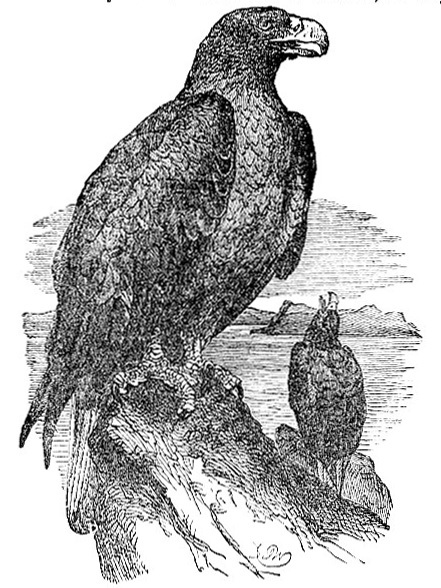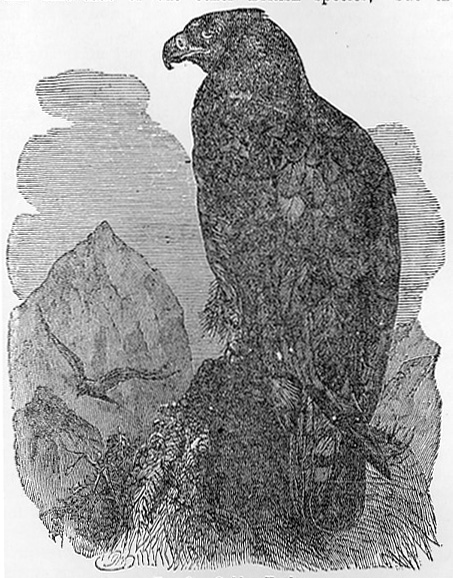1902 Encyclopedia > Eagle
Eagle
EAGLE (French Aigle, from the Latin Aquila), the name generally given to the larger Diurnal Birds-of-prey which are not Vultures; but the limits of the subfamily Aquilinoe have been very variously assigned by different writers on systematic ornithology, and, as before observed (BUZZARD, vol. iv. p. 603), there are eagles smaller than certain Buzzards. By some authorities the Loemmergeier of the Alps, and other high mountains of Europe, North Africa, and Asia, is accounted an Eagle, but by others the genus Gypaetus is placed with the Vulturidoe, as its common English name (Bearded Vulture) shows. There are also other forms, such as the South-American Harpyia and its allies, which though generally called eagles have been ranked as Buzzards. In the absence of any truly scientific definition of the family Aquilinoe it is best to leave these and many other more or less questionable members of the group – such as the genera Spizaetus, Circaetus, Spilornis, Helotarsus, and so forth – and, so far as space will allow, to treat here of those whose position cannot be gainsaid.

Fig. 1 -- Sea Eagle
True eagles inhabit all the Regions of the world, and some seven or eight species at least are found in Europe, of which two are resident in the British Islands. In England and in the Lowlands of Scotland Eagles only exist as stragglers; but in the Hebrides and some parts of the Highlands a good many may yet be found, and their numbers appear to have rather increased of late years than diminished; for the foresters and shepherds, finding that a high price can be got for their eggs, take care to protect the owners of the eyries, which are nearly all well known, and to keep up the stock by allowing them at times to rear their young. There are also now not a few occupies of Scottish forests who interfere so far as they can to protect the king of birds. But hardly twenty years ago trapping, poisoning, and other destructive devices were resorted to without stint, and there was then every probability that before long not an Eagle would be left to add the wild majesty of its appearance to the associations of the mountain or the lake. In Ireland the extirpation of Eagles seems to have been carried on almost unaffected by the prudent considerations which in the northern kingdom have operated so favorably for the race, and except in the wildest parts of Donegal, Mayo, and Kerry, Eagles in the sister-ilsnad are said to be almost birds of the past.
Of the two British species the Erne (Icel. Cern) or Sea Eagle (by some called also the white-tailed and Cinereous Eagle)- Haliaetus albicilla – affects chiefly the coast and neighborhood of inland waters, living in great part on the fish and refuse that is thrown up on the shore, thought it not unfrequently takes living prey, such as lambs, hares, and rabbits. On these last, indeed, young examples mostly feed when they wander southward in autumn, as they yearly do, and appear in England. The adults (fig. 1) are distinguished by their prevalent grayish-brown color, their pale head, yellow beak, and white tail – characters, however, wanting in the immature, which do not assume the perfect plumage for some three or four years. The eyry is commonly placed in a high cliff or on an island in a lake- sometimes on the ground, at others in a tree-and consists of a vast mass of sticks, in the midst of which is formed a hollow lined with Luzula sylvatica (as first observed by the late Mr. John Wolley) or some similar grass, and here are laid the two or three white eggs. In former days the Sea-Eagle seems to have bred in several parts of England – as the Lake district, and possibly even in the Isle of Wight and on dartmoor. This species inhabits all the northern part of the Old World from Iceland to Kamchatka, and breeds in Europe so far to the southward as Albania. In the New World, however, it is only found in Greenland, being elsewhere replaced by the white-headed or Bald Eagle, H. leucocephalus, a bird of similar habits, and the chosen emblem of the United States of America. In the far east of Asia occurs a still larger and finer Sea-Eagle, H. pelagicus, remarkable for its while thighs and upper wing-coverts. South-eastern Europe and India furnish a much smaller species, H. leucoryphus, which has its representative, H. leucogaster, in the Malay Archipelago and Australia, and, as allies in South Africa and Madagascar, H. vocifer and H. vociferoides respectively. All these Eagles may be distinguished by their scaly tarsi, while the group next to be treated of have the tarsi feathered to the toes.

Fig. 2 -- Golden Eagle.
The Golden or Mountain-Eagle, Aquila chrysaetus, is the second British species. This also formerly inhabited England, and a nest, found in 1668 in the Peak of Derbyshire, is well described by Willughby, in whose time it was said to breed also in the Snowdon range. It seldom if ever frequents the coast, and is more active on the wing than the Sea-Eagle, being able to take some birds as they fly, but a large part of its sustenance is the flesh of animals that die a natural death. Its eyre is generally placed and built like that of the other British species, but the neighborhood of water is not requisite. The eggs, from two to four in number, vary from a pure white to a mottled, and often highly-colored, surface, on which appear different shades of red and purple. The adult bird (fig. 2) is of a rich, dark brown, with the elongated feathers of the neck, especially on the nape, light tawny, in which imagination sees a "golden" hue, and the tail marbled with brown and ashy-grey. In the young the tail is white at he base, and the neck has scarcely any tawny tint. The Golden eagle does not occur in Iceland, but occupies suitable situations over the rest of the Palaerctic Region and a considerable portion of the Nearctic-though the American bird has been, by some, considered a distinct species. Domesticated, it has many times been trained to take prey for its master in Europe, and to this species is thought to belong an Eagle habitually used by the Kirgiz Tartars, who call it Bergut or Bearcoot, for the capture of antelopes, foxes, and wolves. It is carried hooded on horseback or on a perch between two men, and released when the quarry is in sight. Such a bird, when well trained, is valued, says Pallas, at the price of two camels. It is quite possible, however, that more than one kind of Eagle is thus used, and the services of a. heliaca (which is the Imperial Eagle of some writers) and of A. mogilnik-both of which are found in Central Asia, as well as in South-eastern Europe-may also be employed.
Of the other more or less nearly allied species or races want of room forbids the consideration, but there is a smaller form on which a few words may be said. This has usually gone under the name of A. noevia, but is now thought by the best authorities to include three local races, or, in the eyes of some, species. They inhabit Europe, North Africa, and Western Asia to India, and two examples of one of them – A. clanga, the form which is somewhat plentiful in North-eastern Germany- have occurred in Cornwall. The smallest true Eagle is A. pennata, which inhabits Southern Europe, and Indian. Differing from other eagles of their genus by its wedge-shaped tail, though otherwise greatly resembling them, is the A. audax of Australia. Lastly may be noticed here a small group of Eagles, characterized by their long legs, forming the genus Nisaetus, of which one species, N. fasciatus, is found in Europe. The Osprey (Pandion), though placed by many among the Aquilinoe, certainly does not belong to that subfamily. (A. N.)
The above article was written by Alfred Newton, M.A., F.R.S.; Professor of Zoology and Comparative Anatomy, University of Cambridge; late Chairman of Brit. Assoc. Migration of Birds Committee; President of the Cambridge Philosophical Society; author of Ornithology of Iceland and A Dictionary of Birds; edited The Ibis, 1865-70 and The Zoological Record, 1870-72.
|

